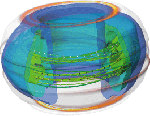
Theory and Computational Sciences Group
The mission of the Theory and Computational Sciences Group is:
- to perform fundamental theoretical research in the theory of fusion plasmas
- to provide theoretical support to the DIII-D National Fusion Facility
- to facilitate scientific discovery in fusion research through the application of advanced computer science techniques.
The Fusion Theory and Simulation program supports the Office of Fusion Energy Sciences’ (FES) strategic goal to Advance the fundamental science of magnetically confined plasmas to develop the predictive capability needed for a sustainable fusion energy source. The Theory Group has expertise that covers a wide spectrum of topics: derivation of analytic theories and models, construction of numerical methods, development and support of advanced simulation codes and software, and verification and validation of software tools. The group also develops and supports a wide array of simulation tools and software used around the world, including EFIT, OMFIT, ELITE, EPED, GATO, GYRO/TGYRO, M3D-C1, NEO and TGLF/GLF23.
MHD Stability
The Theory group has a long history of influential contributions to magnetohydrodynamics (MHD), with notable strengths in both analytic theory and large-scale numerical simulation. The group is a pioneer in validation against experiments, an effort that has been aided immeasurably by close interaction with the DIII-D National Fusion Facility. This is an integral part of our work, ensuring that theories and models remain well-grounded and experimentally relevant. Given our primary focus in Macroscopic Stability on avoiding or mitigating disruptions and other transient events, our work is aimed at providing a more comprehensive approach to the issue of tokamak disruptions, with the tools developed integrated into a comprehensive simulation suite under the OMFIT framework
Confinement and Transport
The integrated experience of the Theory group over 40 years of confinement and transport research is embodied in the suite of state-of-the-art codes that we developed and our knowledge of methods for validation of theory with experimental data. In the long history of pursuit of the goal of producing a validated predictive transport model, recognized as a primary priority by FESAC, a four part strategy has evolved: First, we aim to advance the most physically comprehensive but tractable direct gyrokinetic simulations of ion and electron gyroradius scale turbulence. Second, we develop computationally faster theory based transport models , which are calibrated to the first-principles simulations, in order to predict plasma profiles self-consistent with sources. Third, we have an active neoclassical transport theory research program which is anchored by the high accuracy NEO code for numerical solution of the drift-kinetic equation. Fourth, we validate transport theory with experiment.
Boundary and Pedestal Physics
The physics of the boundary plasma is critically important, both for its strong influence on global confinement, and for its impact on plasma facing materials. In high confinement (H-mode) operation, the pressure at the top of the edge transport barrier (or “pedestal height”) strongly impacts fusion performance, while heat pulses from edge localized modes (ELMs), as well as steady-state heat loads through the scrape-off layer (SOL), can impact material lifetimes. Theoretical and numerical studies of the boundary plasma face a series of challenges, including an extraordinarily wide range of overlapping spatiotemporal scales, as well as complex geometry and dramatic changes in equilibrium conditions over small scales. Despite the many challenges, the Theory group has made substantial contributions to the understanding of the physics of the boundary plasma. Our work has focused on analytic and numerical development of quantitative, predictive and testable models of pedestal constraints, pedestal structure, SOL physics and ELM onset and dynamics.
Integrated Simulation and Modeling
Integrated simulation and modeling has been widely recognized as an essential requirement for the success of the fusion energy mission. It plays a critical role in the interpretation of experimental observations, validation of theory against experiments, development of plasma control techniques, and design of next-step devices such as ITER and Fusion Nuclear Science Facility (FNSF). Our research topics involve myriad physical processes from the plasma core to the edge, and span disparate length and time scales. Our research strongly supports the high-level FES goals of validated tokamak whole-device modeling, and prediction and control of deleterious transient events such as disruption avoidance and mitigation. To this end, we are further enhancing the OMFIT integrated modeling framework, targeting the seamless integration of the capabilities and our tools.
The internal Theory and Computational Sciences web site is accessible via a username/password.
To obtain a web access account, click here.